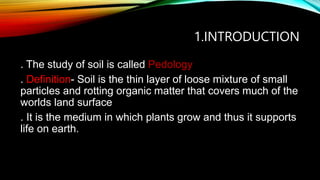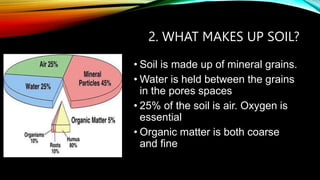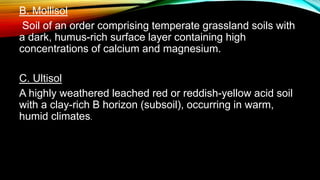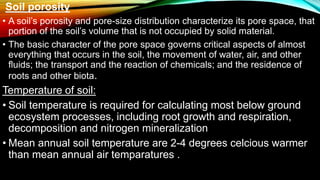Unit6 T.B Mbele.pptx
- 1. UNIT 6: SOIL Mr. T.B Mbele
- 2. 1.INTRODUCTION . The study of soil is called Pedology . Definition- Soil is the thin layer of loose mixture of small particles and rotting organic matter that covers much of the worlds land surface . It is the medium in which plants grow and thus it supports life on earth.
- 3. 2. WHAT MAKES UP SOIL? • Soil is made up of mineral grains. • Water is held between the grains in the pores spaces • 25% of the soil is air. Oxygen is essential • Organic matter is both coarse and fine
- 4. 3. SOIL FORMATION • Soil formation vary depending on what type of soil is forming – clay, sand, or silt. • Three stages of soil formation: A. Erode – Elements of weather cause the rocks, soil, and plant matter in an area to erode and become sediment that contains various minerals and nutrients that were in the previous materials.
- 5. B. Harden – The minerals harden over time to form deposits within the ground – these will later combine with other elements to create the final soil. C. Combine – After humans, animals, or environmental events cause the mineral deposits in the ground to become loose, they combine with organic matter in upper layers of the Earth and build until the soil forms.
- 6. 4. FIVE FACTORS THAT AFFECT SOIL FORMATION . Climate- Temperature, precipitation and how they are distributed across seasons • Biotic factors- Plants, animals fungi, bacteria and other micro-organisms • Topography- Slope position, Aspect and shape • Parent material- Rock, alluvium (Wind or water deposited material • Time- How long the soil has been forming.
- 7. 5. SOIL HORIZON • Soil has three main horizon which are A, B and C. However also O, E and R are considered
- 8. 6. SOIL CLASSIFICATION 1. Alfisol 2. Mollisol 3. Ultisol 4. Spodosol 5. Aridisol
- 9. A. Alfisol Alfisols are arable soil with water content adequate for at least three consecutive months. Alfisols are moderately leached soils that have relatively high native fertility.
- 10. B. Mollisol Soil of an order comprising temperate grassland soils with a dark, humus-rich surface layer containing high concentrations of calcium and magnesium. C. Ultisol A highly weathered leached red or reddish-yellow acid soil with a clay-rich B horizon (subsoil), occurring in warm, humid climates.
- 11. D. Spodosol • a soil of an order rich in aluminum oxide and organic matter, typically characterized by low fertility, and including most podzols. E. Aridisol a soil of an order comprising typically saline or alkaline soils with very little organic matter, characteristic of arid regions.
- 12. 8. Soil colour • The main pigmenting agents in soils are organic matter, iron and to a lesser extent, manganese • When these agents are not covering the mineral grains, the natural colour of the grains is visible 9. Soil naming • Soils are named and classified on the basis of physical and chemical processes in their horizons (layers) • Soil taxonomy uses colour, texture, structure and other properties of the soil8
- 13. 7. SOIL AIR • The volume of space that is not occupied by air particles is known as “pore space” which means soil air • The pore space is usually occupied by water and air • The air filled pores constitute the gaseous phase of the soil system • Oxygen is essential for all biological reactions occurring in soil • Soil air diffuses from atmospheric air by having a higher carbon dioxide and lower oxygen content
- 14. 8. Soil PH • An acidity or alkalinity of a substance is measured in pH units, a scale running from 0 to 14. A pH of 7 is neutral. • As numbers decrease from 7, the acidity gets higher • As numbers increase from 7 so does alkalinity • Soil pH generally range from an extremely acidic pH of 3 to a very alkaline pH of 10. • Most cultivated plants enjoy slightly acidic conditions with a pH of about 6.5.
- 15. 9. Physicochemical reactions of Soil: A. physical properties Structure of soil: • It refers to the arrangement of soil separates into units called soil aggregates • An aggregates possesses solids and pore spaces • The aggregate acts like a larger silt or sand particle depending upon its size.
- 16. Soil density • Soil density is expressed in two concepts as particle density and bulk density. Particle density: • The weight per unit volume of the solid portion is called particle density • Particle density can be expressed in terms of grams per cubic meter (g/m3) • Generally particle density of normal soils is 2.65 grams per cubic meter • Particle density is also termed as true density
- 17. Textural classes Particle density (g/cm3) Coarse sand 2,655 Fine sand 2,659 Silt 2,798 Clay 2,837 Particle density of different soil textural classes
- 18. Bulk density: • The oven dry weight of a unit volume of soil inclusive of pores is called bulk density • The bulk density of a soil is always smaller than its particle density • Bulk density normally decreases, as mineral soils become finer in texture • The bulk density varies indirectly with the total pore space present in the soil and gives a good estimate of the porosity of the soil
- 19. Soil porosity • A soil’s porosity and pore-size distribution characterize its pore space, that portion of the soil’s volume that is not occupied by solid material. • The basic character of the pore space governs critical aspects of almost everything that occurs in the soil, the movement of water, air, and other fluids; the transport and the reaction of chemicals; and the residence of roots and other biota. Temperature of soil: • Soil temperature is required for calculating most below ground ecosystem processes, including root growth and respiration, decomposition and nitrogen mineralization • Mean annual soil temperature are 2-4 degrees celcious warmer than mean annual air temparatures .
- 20. Soil plasticity • Soil plasticity is the property of soil by which it undergoes deformation without cracking or fracturing. • The absorbed water contributes to the plasticity of the soil since it allows the clay particles to slip over another Soil compressibility • Soil compressibility refers to the tendency of soil to consolidate or decrease in volume • The compressibility is partly a function of elastic nature of soil particles and is directly related to settlement of structures • Coarse materials such as gravels and sands have low compressibility and the settlement is considerable less in these materials as compared highly compressible fine grained organic soil
- 21. Soil erodibility • It refers to the ease with which soil materials can be removed by wind or water. • Easily eroded materials include unprotected silt, sand and other loosely consolidated materials, cohesive soils (with more than 20% clay) and naturally cemented soils are not easily removed from its place by wind or water and, therefore have a low erosion factor.
- 22. 10. Chemical properties A. Inorganic matters of Soil • Compounds of aluminum, silicon, calcium, magnesium, iron, potassium and sodium are chief inorganic constituents of soils. • Chemical composition of soil of one horizon differs greately from composition of soil in the other horizon. B. Organic matter of soil Organic component of the soil consists of organic origin; living ad dead In sand soil of arid zone, it is found in every poor quantity (one or less than one per cent) but in peaty soil, it may be as high as 90%
- 23. C. Buffer action: • Buffer action of soil chemistry refers to the resistance to change in pH of a system • Property of soil to resist a change in pH is called “buffer action”. • Buffer solutions are usually formed of a mixture of salt of weak acid and acid itself D. Buffering in soil: • Soils should have good buffering capacity. Therefore, it is necessary to add considerably large amount of acids or alkalis in order to bring about any change in the original pH of soil. • Phosphates carbonates , bicarbonates and other slats of weak organic acids are important buffering agents in the soils
- 24. 11. Soil Chemistry in relation with Environment • Soil chemistry has traditionally focused on the chemical reactions in soils that affect plant growth and plant nutrition. • However, beginning in the 1970s and certainly in the 1990s, as concerns increased about inorganic and organic contaminants in water and soil and their impact on plan, animal, and human health the emphasis of soil chemistry is now o environmental soil chemistry • Environmental soil chemistry is the study of chemical reactions between soils and environmentally important plant nutrients, radionuclides, metals, metalloids and organic chemicals























